Reine des Violette.... Going to toss it!!??
Hi,
I own three RdV, all planted during the Fall or this past winter, and honestly, I am ready to toss one of them for sure. Reine des "Violettes" in my mind should be violet, not the hot pink I see on both of my own root plants. The one in the backyard will likely remain because that area has hot colors and it is okay there, but for the front area, it is all wrong.
Do any of you all have any information that can save this rose?
Lynn
Comments (45)
ingrid_vc so. CA zone 9
10 years agoI'm one of those trying to grow penguins in the desert since I recently also acquired this rose. I took the precaution of planting it where it receives mostly morning sun and it does receive lots of water but that's all I've done. Would it help to use fertilizer that's meant for azaleas and camellias?
Ingrid
Related Professionals
Canton Landscape Architects & Landscape Designers · Tempe Landscape Contractors · Dixon Landscape Contractors · Farmington Landscape Contractors · Goodlettsville Landscape Contractors · Kailua Landscape Contractors · Nashua Landscape Contractors · North Lauderdale Landscape Contractors · Santa Ana Landscape Contractors · Goldenrod Landscape Contractors · Agoura Siding & Exteriors · Largo Siding & Exteriors · Manassas Siding & Exteriors · Weymouth Siding & Exteriors · Iowa City Siding & Exteriorsmalcolm_manners
10 years agoWhile I'm sure Kim's observations are exactly correct, I hope you don't presume, then, that it requires cold weather. In our acid soils with humid heat (seldom over 100 F but often into the upper 90s, and at least 90 every day, June through September) and brilliant sun, it stays nicely blue-purple throughout the year.
MalcolmLynn-in-TX-Z8b- Austin Area/Hill Country
Original Author10 years agoOh my….RdV, the one that may need to leave, is growing in a large pot. My water is 7.6 pH, so alkaline, and the rose receives morning sun with a little afternoon sun. The temperatures just began to really hit the 80's here over the past couple of days, although we are headed back toward the 70's in a couple of days, and for the most part, it has been in the 60's and 70's since February. The one in the backyard had soil that was heavily amended months prior to it being planted. If these roses are doing this now, I cannot imagine what will happen in several weeks:(
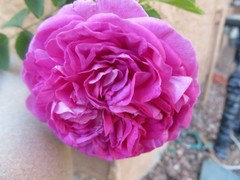
SouthCountryGuy Zone 4b-5 SE BC
10 years agoI just got this rose from pickering and hope to see blooms like pictured....amazing how roses differ garden to garden.
What a beaut! desertgarden561!!!!!!!
Kippy
10 years agoMine is pink too.
But if I was you, I would wait and see how it is doing after a year. Never know, you might have some others out there that were supposed to be a different color and they are not so they all work after all.
The other think you could try is to pot it in azalea soils and see if that helps the cause
Lynn-in-TX-Z8b- Austin Area/Hill Country
Original Author10 years agoKippy,
I used a mix of M.G. Potting soil, Orchid or African Violet potting soil (I no longer have any and cannot remember which) and sphaghum peat.
I may put RdV back into a 5 gallon pot and let it grow there for a while. Most of my roses are immature as is my garden, so I cannot get instant gratification that way, but had hoped to see the color scheme I envisioned.
nikthegreek
10 years agoIngrid,
I have learnt from years of experience plus reading and talking with experts, that once a woody plant is in a soil that for whatever reason is too alkaline for it, there is very little one can do to improve the conditions. Sulphur may help but it can take a lot and a long time and will never change the pH at the depth it is required for a deep rooted plant. Low pH fertilizers (main acidic fertilizers are ammonium sulfate and potassium sulphate) can help, mulching with blond unlimed peat or pine can help, applying iron sulfate may help, but none of these are long term solutions and none of these will have a real deep effect. 20-30cm deep is the most one can expect, good for grasses and some perennials but not for most woody plants.
To add insult to injury, the amount of acidic ammendments one has to use does not only depend on the existing pH but on the buffering capacity of one's soil and has to be determined by an expert following a soil test.
On top of that, if one's water is alkaline this will need to be fixed which is a big pain unless one has installed appropriate fertigation equipment and is prepared to deal with acids. So, all in all, it is not worth it in my opinion.
One can uproot the plant and re-plant it in soil well ammended (sometimes complete replacement may be required) with acidic substrata but even that will slowly go downhill if one is required to irrigate with alkaline water often.
So I'm fully with Kim on that. I'm not commenting on the particular rose which I have never grown, I'm just talking in general about cultivating more or less acid loving plants in alkaline soils and dry conditions.
Nikingrid_vc so. CA zone 9
10 years agoNik, thank you for that very detailed and helpful explanation. Since I happen to be very fond of lavender pink roses such as Lynn pictures, life as we know it will not end if that's all I ever see on my RdV. The fragrance and shape will still be there, and I'll still have a rose with a beautiful name.
Ingrid
portlandmysteryrose
10 years agoLynn, everything I'm reading here matches my experience...or rather it matches my opposite experience. Or something like that. Here in PDX, the soil and climate seem to be exactly what are needed to produce those purplish blooms. If you're ever up for a transfer to this area again, Reine might be a good one to grow. Carol
Lynn-in-TX-Z8b- Austin Area/Hill Country
Original Author10 years agoYesterday evening, I discovered one big thing RdV has going for it, the fragrance is lovely!! My DH actually alerted me to this, as he is always sticking his nose in the roses around the yard and RdV was no exception. That solved it! In a pot and off to the deck or backyard it goes.
Carol, we have not ruled out a transfer, it is on the back burner:)
Lynn
portlandmysteryrose
10 years agoAh, yes. The fragrance. I'm glad you are potting her up. May she behave in her new location. Wow, a DH that stops to smell the roses! Hang on to him. He's a catch. :-) Carol
roseseek
10 years agoRdv also has the sweet peppery scent to the sepals, peduncles and new growth tips when they are very fresh and soft. Kim
jaspermplants
10 years agoI tried RdV once and it seemed to hate my climate. I have seen it growing here however. But I really don't have any room for it, or I'd probably try it again.
nikthegreek
10 years agoPotting it up will make it easy for you to provide the more acidic substrata Kim is recommending. MIxing a bit of vinegar in the water once or twice monthly during the watering season will make sure the soil will remain so for long.
NikThis post was edited by nikthegreek on Sat, Apr 12, 14 at 0:40
roseseek
10 years agoShield the pot to keep it cool. Hotter roots will continue the pink tones; reduce the size and quantity of the flowers and fry them to potpourri faster. Kim
Lynn-in-TX-Z8b- Austin Area/Hill Country
Original Author10 years agoNikthegreek, I am not brave enough to use vinegar on plants unless I would actually be trying to give it a dose to rid my garden of it; I am confident I can do that:)
Kim thanks for the information regarding RdV and what to do with it when it becomes hot here. I still have one that is on the front/side of the house near a gate and it is grafted. I am very reluctant regarding moving it and I really do not know how I will like it next to Bishop's Castle if it is hot pink. It has buds on it that are covered with aphids. I really need to get out there with the hose.
Lynn
ingrid_vc so. CA zone 9
10 years agoLynn, I'll be curious to hear how it works with Bishop's Castle. I would think that RdV will always have enough of a bluish cast that it will work with BC. I've found that if a rose has enough foliage the large areas of green help to harmonize slightly different colors.
Ingrid
nikthegreek
10 years agoHa ha Lynn! Aspirin can kill you if you take too many... What if I told you that concetrated suphuric and nitric acids are used by farmers in fertigation systems. It's all a matter of dilution. One tbsp of vinegar in the gallon every once in a while will help and will not harm your plants and will help any that appear chlorotic. Lots of people are using vinegar to acidify the water as a matter of routine when watering plants like azaleas and the like. It's no good if one uses it constantly (due to other things vinegar contains rather than the acetic acid in it) but at the rate of once or twice a month it's totally ok.
Tessiess, SoCal Inland, 9b, 1272' elev
10 years agoHere is my RdV. This picture represents the color best, although the image itself is blurry. I really like the color of the flowers, and the leaves are a nice mid green.
I'm a very lazy gardener. I don't do soil amendments or tinker with the water. Both here are quite alkaline. RdV is planted in ordinary garden soil. The only thing this rose gets is water straight out of the hose, and infrequent feedings of diluted fish emulsion (not only lazy, I'm frugal too!). If any rose isn't happy with this kind of treatment, it is destined to meet Mr. Shovel.;)
Melissa
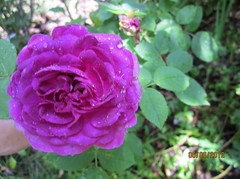
seil zone 6b MI
10 years agoI'm really sad to hear that RdV is such a disappointment in some places. I must be one of the lucky ones because mine is always that smoky lavender color. The scent is truly amazing and besides all of that it's thornless! My favorite rose to prune, lol! For me I just wish it had better rebloom.
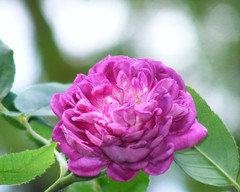
Lynn-in-TX-Z8b- Austin Area/Hill Country
Original Author10 years agonikthegreek,
Thanks for the rate of dilution. There was a poster on this forum " Strawberryhill", who really promoted the use of vinegar and even molasses, but if I recall, it was a specific molasses that was being recommended, and under certain circumstances with specific roses I believe there were issues with the use of vinegar for her too. I am not attached to the one RdV at this point, and would experiment a bit with it, but do not know what kind of vinegar people use (white, apple cider…..)?
Ingrid, I hosed the aphids off of RdV this morning and believe the buds will likely be open in a couple of days. Bishop's Castle is in bloom with buds about to open too. I will try to capture an image of the two together and post it.
Lynn
Kippy
10 years agoI plan on taking better pictures in the morning, but my RdV is on the green Tutor (note the super yellow leaves are the old ones she is just deciding to drop) She is the smaller of the hot pink blooms. The big hot pink is Young Lycidas
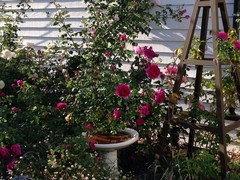
nikthegreek
10 years agoLynn, any vinegar will do as long as it is less than 10% acetic acid, just to be on the safe side. I have used wine vinegar just because it is the one most available and cheap over here. I suppose so called 'distilled vinegar', which is a misnomer since it is not distiled but it is made out of distilled alcohol, would be best since it has no other ingredients apart from water and acetic acid. The dilution rate I have suggested is just an indicative starting point. People who take this seriously use some kind of pH testing means (pH colored strips are the most reliable imo unless one is colour blind ) and test for the pH of the solution to be around 5-6 i.e. similar to rain water. One can use any other acidifying agent (acid) at an appropriate rate of dilution to bring the pH down to this range. Organic acids like acetic and citric undergo quick breakdown in the soil so their effect is not long lasting. Sulfuric, nitric and phosphoric acids are used in the farming industry. There are also ready made products available (one such is called 'pH Down' in the States) which usually contain phosphoric acid at a dilution rate safe for amateur handling and they are often used in hydroponics (usually in amateur home cultivation of 'recreational' plants....).
Nikportlandmysteryrose
10 years agoI amend soil with used tea leaves and coffee grounds to turn hydrangeas blue. I save a batch in a refrigerated container and then periodically trowel it in under the plants.I believe a member once posted that coffee grounds lose their acidity when the coffee is made, but the grounds must be acidic enough to work over time. Both kinds of leftovers produce gradual results and have to be applied repeatedly long before and up to summer bloom. In PDX, my soil is slightly acid, but I amend my Gentian Dome and other hydrangeas with morning beverage leftovers to push deeper blues. If I were trying to blue up a rose, I might experiment with this method, too. Just thinking out loud. :-) Carol
fredness
9 years agoI wanted to plant RDV until I read this thread. I am relandscaping my yard in east San Diego and the soil has the alkalinity previously mentioned by roseseek. I do plan to amend it but don't want to fight a losing battle.
Are other roses going to struggle with slightly alkaline soil? The others I plan to use are New Dawn, Don Juan, Dublin Bay, Golden Celebration, Zéphirine Drouhin.
Any suggested purple/violet replacements for rdv for this environment? I looked on help me find but I would have found rdv there also. Under "any purple" they show...
Dakota redwing
Dinky
Gloriana
Mercedes GallartDoes anyone have any experience with any RDV substitute?
Marlorena
9 years ago...it's strange to read this, as Reine des Violettes grows well here on alkaline soils.... needs to be fairly rich though I believe....
Kippy
9 years agoI have heard that ZD loves mildew and know they sell it locally and I have yet to see the plant look worth buying here in Santa Barbara
ingrid_vc so. CA zone 9
9 years agofredness, I ditched my RdV some time ago after inquiring about it for my climate (east San Diego county) and having the overwhelming response that it would be a poor bloomer and seldom have the purplish coloring. I just recently bought Fragrant Purple which smells divine and had a lovely flower which doesn't look as though it would turn pink, but I can't verify that.
I just wanted to mention that New Dawn is not a good choice in our climate, it needs moisture and lower temperatures to bloom well, and the vicious thorns are awful. There are many climbers better suited to our area among the teas and Tea-Noisette hybrids, Reve d'Or being my favorite (as long as you don't plant it against a hot wall as I did). Zepherine Drouhin is very fragrant and puts on a great display in the spring but then not much after that, and the flowers don't have a great shape either. Our area is perfect for tea roses, Chinas, Bourbons like Souvenir de la Malmaison (my best overall rose), polyanthas and some of the Austins like Bishop's Castle and Carding Hill.
Ingrid
rosefolly
9 years agoMarlorena, it is strange but I know it is true. Jon in Wessex grows RdV successfully on a soil sited over a pure chalk bedrock. I've wondered about this before, and your comment reminded me of that.
Possibly our alkaline soils are alkaline for a different reason, perhaps having to do with irrigation with alkaline water? Many of us with alkaline soils are in the semi-arid to arid West and cannot depend on natural rainfall. It only rains in the winter here (if then).
Rosefolly
Marlorena
9 years ago..I see, it's a difficult one isn't it Rosefolly..?.
.. my tap water is very alkaline but if I want to water just one or two plants - I have Rhododendrons and Camellias - and I have no collected rainwater left in my collection butts - then I just fill a bucket of water from the tap or hose and mix in some acidifying liquid fertilizer suitable for those plants..... I do this when I notice any leaf yellowing....
...a little cumbersome, but I'm not watering the whole garden this way....
...I wonder if this particular rose for instance might benefit from something like that, if it's showing signs of underperforming....
rosefolly
9 years agoMaelorena, perhaps it would. But most of us in the arid West have our entire gardens on a spray irrigation system or drip lines run by an automatic controller, a sort of artificial rain. It would be difficult to water one plant separately if it were planted in the ground. It could work for someone willing to grow this rose in a separate bed watered by hand.
Rosefolly
jerijen
9 years agoTruth is -- and we grew it for 20 years -- RdV is not well-suited to our conditions. The only good thing about it, here, was that we had enough cool weather (then) that the blooms really were purple.
I now grow "Forest Ranch Pom-Pom" -- a Found Rose from NoCal ... It holds the purple bloom color, and is not constantly flirting with chlorosis. But even FRPP, I think, would like more winter chill than we normally get.
Jeri
Coastal Ventura Co., SoCal(Here is FRPP, in the Sacramento City Cemetery. I've seen it "bluer," but it is a magnificent rose, there.)
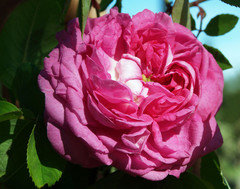
Marlorena
9 years ago...probably impractical on a long term basis Rosefolly...and we go back I suppose to thinking we should be growing plants suited to our locales... but then I think gardening life would be rather boring if we didn't take chances and run risks....one must have trial and error....
...to be honest, I am a little surprised though that California allows gardeners to use automatic controllers or any kind of artificial irrigation when you consider the lack of rainfall long term that's going on right now...
...I think in Australia for instance, in some parts like Brisbane, they are not allowed to water their gardens on certain days and have quite strict restrictions in place....
...I sincerely hope it doesn't come to that for any of you, but do wonder if one day soon it might....edit...that's a pretty rose Jeri... and I hope it has some scent to go with it...
This post was edited by Marlorena on Fri, Feb 6, 15 at 18:57
rosefolly
9 years agoWe do have limitations on when and how much we can water. We are encouraged to use drip irrigation because it is considered to be a thriftier use of water.
mustbnuts zone 9 sunset 9
9 years agoThis is such a great thread. I am glad it was resurrected.
Malorena, I am also in Calif and we have water restrictions all year long. Right now, I can only water one day a week and then only before 7 am or 7 pm. Come April 1st, I can water twice a week. Same time restrictions however. Really doesn't work for potted plants as it is so hot here in the summer (doesn't cool off until November).
In the county north of me, they could not water at all last summer. Lots of dead yards there, I am concerned about the dead trees as all it will take is a good wind to knock them over into someone's house.
Meanwhile, big Ag is still digging deeper and deeper wells (they have the money for it) and lowering our aquifer. There were towns nearby that had to have bottled water delivered in order to have any water at all to drink, brush their teeth, cook with, use the toilets, etc.
roseseek
9 years agoIt probably has to do with HOW alkaline the soil and water are. Where I've grown RdV, the water stains any surface it dries on. Eflourescence is heavy, often requiring CLR to dissolve it before it becomes too thick and set. Many types suffer chlorosis in this water. RdV, budded on Huey, required heavy peat and Ironite applications on a regular basis to keep its leaves green and flowers in the mauve shades instead of white and white. Own root, it was only suited when grown in a pot of acidic potting soil. I seriously would treat it as you would an azalea, camellia or gardenia. Many other "violet" roses experience similar problems in these conditions. Cardinal Hume never has, which is what led me to try it as a stock for the violet roses. It works perfectly. I haven't seen the cholorsis issues here on the newer violet roses on stocks. Kim
Kippy
9 years agoMine is getting a considerable amount of gray water, thinking soap is usually alkaline and not helping the matter.
But I have blueberries near by so it is not that hard to put soil acidifier on her while doing the blueberries.
Marlorena
9 years agomustbnuts..... thank you for your reply, I wasn't aware of that.... clearly a difficult place to garden for many....yet the Tea roses are always so lovely.... here we are more flood prone being on a coastal flood plain with a high water table....
...that's an interesting point about the different rootstocks.... I think ours here are mostly on R. canina 'Laxa' variety.... perhaps that makes a difference... I had certainly not heard of 'Fortuniana' or 'Dr. Huey' before I visited this forum....
jerijen
9 years agoActually, Marlorena, Over the course of time, there have been MANY different roses used for rootstock plants! Still are, really. It's not "All-Huey-All-The-Time." The good news is that several things that have been used that way turned out to be garden-assets, if/when they "took over" the intended rose.
One of my personal favorites is 'Gloire des Rosomanes' ("Ragged Robin") which is a GREAT rose for our area -- called a Bourbon, but seeming more-China to me. (Check it out on HelpMeFind.)
'Fortuniana', of course. We find big old plants of that in old cemeteries. My huge one came from a cemetery.
Then, 'De la Grifferaie' -- WOW! Mel Hulse used to say that if 'De la Grifferaie' was a remontant rose, it would be one of the most popular roses in the world. He was likely correct.
Burling Leong (Burlington) still uses 'Pink Clouds' particularly for trees. And of course, IXL was used in the same way -- so, that's yet another thing we find in cemeteries.
Another gorgeous rootstock is Manetti. Something about Manetti always makes me think of Easter Eggs. :-)
I know Kim can think of many more.
Jeri
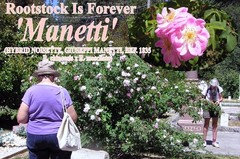
Marlorena
9 years ago.'de la Grifferaie' is one I had heard of...as I'm pretty sure they used that as an understock here years ago, I recall reading about it when I first started to garden...
...I don't know the others.... they seem well suited to your area.....and I can see where Gruss an Teplitz gets its colour from.......it must be great fun and a worthy interest to have, in finding these old roses growing so well there, seemingly all over the place... I'd have to carry a parasol though for the heat....
..kind regards....Tessiess, SoCal Inland, 9b, 1272' elev
9 years ago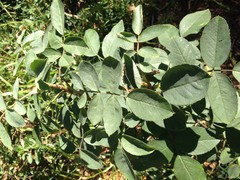
Just as an update, here is a photo of my Reine des Violettes, taken this morning. This is the color the leaves have always been, with no soil amendments, nothing at all done to change the ph. Soil is quite alkaline, and we get very little rainfall, so she gets regular city water, but not that much (neighbors are water-sipping Salvia mellifera, a CA native Salvia cross, and multiple CA native grasses). She is planted near the base and smack in the root zone of an 80+ foot tall ash tree, so the soil is anything but rich (fairly sandy and rocky). On the latest water company annual report the average ph of the water was 7.8 (with a range during the year of 7.3 to 8.5). Rarely have I fertilized this rose, and if I do it is only with fish emulsion diluted to 1/2 strength recommended on the bottle, and she has to share with 4 or 5 other roses a 2-gallon watering can dose among them.
RdV grows in England on chalk which is very alkaline and in my garden which is also alkaline. I do realise others are having problems with pale leaves, but perhaps alkalinity is not the problem. If it isn't then all the acid soil amendments and fertilizers won't fix it. And from what I've been reading about what people that do get the pale leaves/pink flowers on their plants is, that those treatments are not successful. That gets me back to the point that maybe the assumption of what the problem is, well, isn't it.







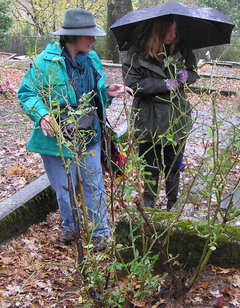




roseseek